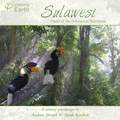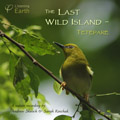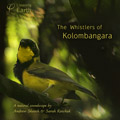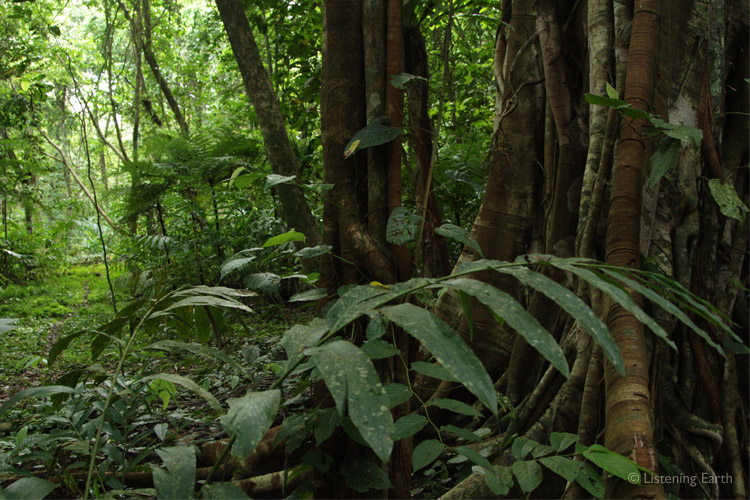

Running Time:
70 min
Release Date:
October 2012
Recording Location:
Tetepare Island, Solomon Islands
View on Google Earth
If you like this album,
we also recommend:
The Monarchs of Tetepare
The White-capped Monarch is a small bird of the flycatcher family, found only on a few islands in the central Solomon Islands. At 5am, on the rainforested island of Tetepare, they begin their hauntingly beautiful predawn singing.
Each bird gives a series of single, pure-note whistles - hesitant and slightly tremulous. At first only one or two birds call, ethereal and hypnotic in the night. The magic develops as more birds join in, each bird singing its own note, together making a kind of organic music; an elfin choir in the forest.
A chorus of nocturnal insects call softly, along with wildlife characteristic of these Pacific islands; eyelash frogs, 'kissing' bats, megapodes, white-eyes and koels. The sound of waves breaking carries faintly from the distant reef.
This album is a single continuous recording - a deeply peaceful and unique soundworld.
Andrew comments:
"There are times in our field recording when we come across something utterly unexpected and wonderful. This was one of those occasions.
"At first I was enchanted with the idea that these birds were singing in a musical scale. Actually, it seemed more like one of the old medieval church modes, which predate our modern scales, and specifically, the Aeolian mode. This we would now call a minor scale.
"However nature is not a musical system, and whilst our music is specifically pitched, these birds weren't singing like that. A musician may describe them as singing in micro-tones, quavering their notes and gliding them almost imperceptibly. In reality, it would be more accurate to say that a musical ear may perceive the illusion of a scale, but frequently, they'd sing tones that were not on the modal scale at all.
"What I can say is that the whole experience of being in the rainforest, with faint shafts of moonlight penetrating the canopy, and these wonderful sounds around us, was utterly enchanting. Deeply relaxing. It was a unique occasion, rarely heard, and only in that localised region of the Solomon Islands.
"We decided that the effect is so restful that many would enjoy listening to the complete recording. It is one of those soundscapes that just lulls you hypnotically, yet it is always changing."
Acknowledgements:
Our thanks to the Tetepare Descendants Association, formed by the local community to protect the island against what are often predatory and unsustainable logging practices. www.tetepare.org
In particular we'd like to acknowledge the friendship of Mary and Twomey, the latter for his gentle companionship as our local guide while on the island.
Audio sample of this album
|
1. |
The Monarchs of Tetepare |
69.31 |
Photographing the rainforests of Tetepare Island
Our mornings begin early - 4am early! We are ready to go by 4.20am and meet up with Twomey (pronounced Too-mee), our local guide and companion while on Tetepare island. We walk one and a half kilo...
Read more >'Music of the Birds'? - The Monarchs of Tetepare Island
When we describe birdsong as 'nature's music', we often mean it more poetically than technically. The reason I think is that our music is based around scales and melodies - that is what...
Read more >Purchase this
album as:
Digital Album
(for immediate download)
Download this album
for as little as
$7.50 -
View Special Deals
(Prices AU$, exGST)
Mp3:
Mp3 is a universal audio format, playable on iPods, computers, media players and mobile phones.
Mp3 is a compressed format, allowing smaller filesizes, offering faster download times and requiring less storage space on players, but at some expense to the audio quality. Many listeners can't really hear the difference between mp3 and full CD-quality audio, and hence its convenience has lead to it becoming the default option for audio.
Our albums are generally encoded at around 256kbps (sometimes with VBR), balancing optimal audio quality without blowing out filesizes excessively. We encode using the Fraunhoffer algorithm, which preserves more detail in the human audible range than the lame encoder.
Our mp3 files are free of any DRM (digital rights management), so you can transfer them to any of your media technology. You've paid for them, they're yours for your personal use without restriction.
Mp3 files can be burned to disc, either as an mp3 disc, or an audio CD after converting them to a standard audio (.wav or .aif) format first.
FLAC:
FLAC is a high-quality audio format, allowing CD-resolution audio. It is ideal if you wish to burn your files to a CDR, or listen over a high resolution audio system. However files usually require special decoding by the user before playing or burning to disc.
FLAC (Free Lossless Audio Codec) is a LOSSLESS compressed audio format. This means that it preserves the full audio quality of a CD, but optimises the filesize for downloading. Typically, file sizes of around 60% are achieved without any degradation or loss of audio quality from the source files at the CD standard of 16bit/44.1kHz.
Obviously the file sizes are larger than for the mp3 version - usually around 300-400Mb for an album, compared to 100Mb for an mp3 album.
In addition, you'll need to know what to do with the files once you've downloaded them. In most cases you'll want to decode the files to wav or aiff, either to import into programs like iTunes, or burn to CDR. Some programs will play flac files natively.
There is a lot of information about flac online (eg: http://flac.sourceforge.net/)





 Alternate audio link
Alternate audio link 